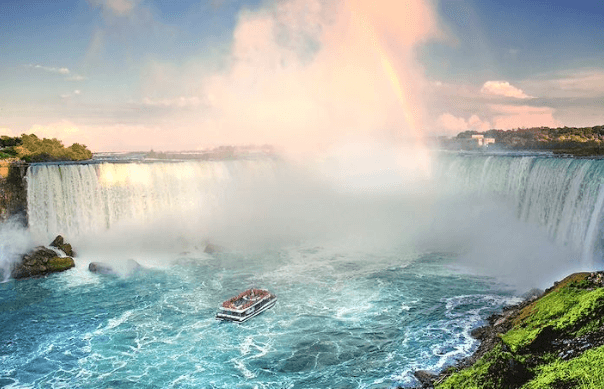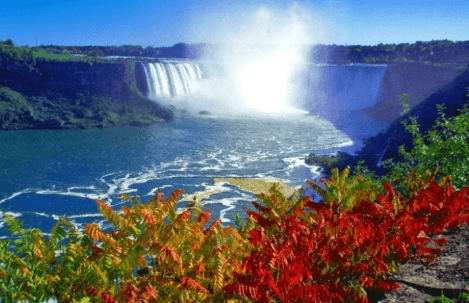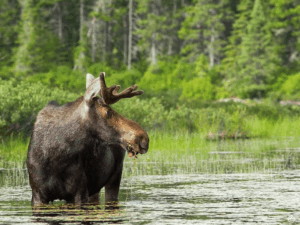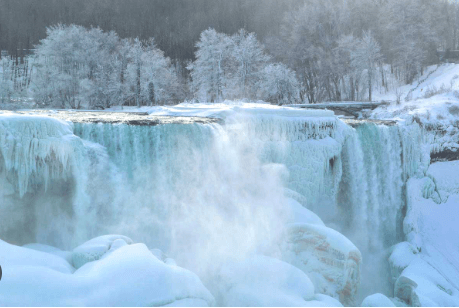
Niagara Falls Conservation: tourism & nature 🌿
What keeps these majestic falls wild? 🌿 Niagara Falls conservation teams, from both Canada and USA, juggle tourism and nature. Explore the NPCA’s and other nature conservation bodies works—from the Butterfly Conservatory to wetland projects—ensuring this icon’s future. 🌎
Before detailing the conservation measures in place at Niagara Falls, here are the contact details of the official organizations involved in protecting and promoting this natural paradise. You may reach out to them for the most up-to-date information regarding their ongoing sustainable initiatives, online or in face to face.
Information Niagara Falls Phone Number and Contacts (Niagara Parks Commission) for Canada : +1 (877) 642-7275 (free) or +1 (905) 356-2241 / Website : www.niagaraparks.com
- Email : info@niagaraparks.com
- Address : 7400 Portage Road South, Niagara Falls, ON, L2E 6T2, Canada
Niagara Falls Conservation Main Organizations (Canada)
| Organization Name | Website | Phone | Mission |
|---|---|---|---|
| Niagara Parks Commission | www.niagaraparks.com | (905) 356-2241 | Preserve and manage the Ontario shoreline of the Niagara River and Falls |
| Niagara Peninsula Conservation Authority | npca.ca | (905) 788-3135 | Manage and protect watersheds, ecosystems, source water, and flood control |
| Niagara Escarpment Commission | escarpment.org | – | Conserve the UNESCO Niagara Escarpment Biosphere Reserve |
| St. Lawrence Parks Commission | parks.on.ca | – | Manage heritage and conservation parks along the St. Lawrence River |
| Conservation Ontario | conservation-ontario.on.ca | – | Crown agency umbrella for regional conservation authorities |
Information Niagara Falls Phone Number and Contacts (Destination Niagara) for USA : +1 (877) 325-5787 or +1 (716) 282-8992 / Website : www.niagarafallsusa.com
- Address : 10 Rainbow Boulevard, Niagara Falls, NY 14303, United States
- Opening : Du lundi au vendredi, From Monday to Friday, from de 8:30 AM to 5:00 PM
- Onsite Welcoming : Everyday, from 8:30 AM to 5:00 PM
📍 Niagara Falls Conservation Main Organizations (USA)
| Organization Name | Website | Phone | Mission |
|---|---|---|---|
| Niagara Falls, NY Planning & Environmental Dept | niagarafallsusa.org | (716) 760-4470 | Oversee land-use, floodplain, brownfields, environmental planning |
| Niagara County Soil & Water Conservation District | niagaraswcd.com | – | Protect soil and water resources in Niagara County (NY) |
| Niagara Falls, NY Forestry Services | niagarafallsusa.org | (716) 286-4311 | Maintain urban forestry and city trees |
| Niagara Falls State Park (NYS Office of Parks) | parks.ny.gov | – | Manage and conserve the oldest U.S. state park at Niagara Falls |
| U.S. EPA – Niagara River Remedial Action Plan | epa.gov | – | Monitor, clean up, and restore Niagara River ecosystem |
Article Takeaways
Niagara Falls conservation efforts focus on pollution control, waste reduction, and sustainable initiatives to protect both water quality and biodiversity. Habitat restoration and fisheries management programs help maintain the health of the watershed and support Niagara Falls wildlife. Conservation areas, such as Chippawa Creek, limit urban development and preserve natural ecosystems. Cross-border cooperation between Niagara Falls, Ontario, and Niagara Falls, USA, ensures coordinated environmental strategies. Public education and projects like butterfly conservation at Niagara Falls raise awareness about the importance of protecting this iconic natural site.
Table of contents
- Conservation Initiatives Protecting Niagara’s Natural Wonder 🌊
- Biodiversity and Habitat Protection in the Niagara Region 🌿
- Future Conservation Challenges and Sustainable Initiatives 🌎

Conservation Initiatives Protecting Niagara’s Natural Wonder 🌊
Niagara Falls, a natural marvel, faces threats from tourism and pollution. 🌊 The Niagara Peninsula Conservation Authority (NPCA) leads efforts to balance preservation with visitor access, ensuring this iconic site remains protected for future generations. As Current Challenges in the Conservation of Sites from Antiquity article notes, it’s part of one of the world’s earliest international conservation pacts.
The Niagara Peninsula Conservation Authority (NPCA) manages 43 conservation areas across Ontario’s Niagara region. 🌿 They implement watershed management strategies like flood risk reduction, water quality monitoring, and invasive species control. By protecting over 2,400 acres of natural land and restoring habitats, the NPCA safeguards biodiversity. Their work aligns with regional climate resilience goals, balancing ecological health with community needs through sustainable land use planning and public education programs.
Here are examples where protected spaces conservation meets exploration:
- Niagara Glen Nature Centre with guided trails in the Carolinian forest
- Ball’s Falls and other GeoHikes revealing unique geological formations
- Niagara Escarpment, a UNESCO World Biosphere Reserve
Niagara Parks balances tourism with conservation through sustainable practices, making the place a global model for ecotourism. 🌍 Initiatives include eco-friendly cruises, local ingredient use, and plastic reduction. Guided tours educate visitors, while green infrastructure like solar energy and water stations reduce environmental impact, ensuring the Falls’ beauty endures for generations.

Biodiversity and Habitat Protection in the Niagara Region 🌿
Over 2,250 species thrive in Niagara’s protected areas, including butterflies, especially at Butterfly Conservatory’s, where you can discover 40+ free-flying butterflies species. 🦋 Rare Carolinian forest species and UNESCO-protected Niagara Escarpment ecosystems highlight why conservation here safeguards some of Canada’s most fragile biodiversity. Sustainable initiatives are numerous to respect and promote Niagara region heritage, and below you can find a list of the most interesting and impactful:
- Indigenous stewardship via Dish with One Spoon Wampum agreement guiding sustainable land use
- Métis and Inuit communities collaborating on watershed management and species protection
- Traditional knowledge informing alvar habitat restoration for extreme-condition species
- Cultural burns mimicking historic land practices to maintain prairie ecosystems
- Ethical trading systems connecting visitors to Indigenous ecological practices
Wetland restoration projects like Gonder’s Flats use goats to control invasives before replanting native vegetation. 🐐 Niagara Parks restored 7.5 hectares of coastal wetlands since 2016, while the Bruce Trail Conservancy secures sensitive escarpment lands. Twelve Mile Creek improvements focus on riparian planting to filter runoff, protecting aquatic habitats.
Up for a walk? the Niagara Glen’s trail is a 4km trail wind through Carolinian forests sheltering 490 vulnerable species. 🌳 Other selected guided tours explain geological history and ethical trading programs let visitors exchange fossils for conservation knowledge. Also, over 60m elevation changes demonstrate ecological fragility, making the gorge’s unique topography a living classroom for environmental stewardship.

Future Niagara Falls Conservation Challenges and Sustainable Initiatives 🌎
Niagara Falls faces erosion (0.1m/year), climate-driven water level drops (up to 0.47m by 2050), and pollution from agricultural runoff. 🌊 Balancing tourism with 168,000m³/minute water flow requires strict development controls and cross-border watershed management by NPCA and US partners.
Innovative projects tackle these issues from several approaches:
– Fisheries: Artificial reefs and riparian planting restore native species like lake sturgeon 🐟
– Pollution control: Niagara River Toxics Management Plan reduced priority pollutants by 94% since 1989 🧪
– Waste reduction: Solar-powered waste stations and plastic-free cruise operations 🌬️
– Binational collaboration: 44 habitat restoration projects since 1994 through Great Lakes Restoration Initiative 🌍
Tourists directly support conservation by joining habitat restoration projects or adopting zero-waste practices during visits. 🌿 Every plastic-free souvenir purchase or guided eco-tour choice helps protect this shared wonder between Canada and America.
Niagara’s magic isn’t just in its thundering 💧 but in the delicate dance of conservation keeping it alive. From NPCA’s stewardship to eco-smart tourism and Indigenous wisdom 🌿, protecting this wonder takes all of us. Tread lightly, explore deeply—your visit can help preserve its splendor for generations. Let’s keep the falls roaring 🌎.
Q / A About Niagara Falls Conservation
Alright, let’s talk butterflies! 🦋 Entry to the Butterfly Conservatory will set you back $20 for adults (13+) and $13 for kids aged 3-12. Little ones under 3 get in free, which is a nice touch. It’s a pretty magical spot, so if you’re into fluttering beauties, it might be worth the splurge.
Located within the Niagara Parks Botanical Gardens, the Conservatory is home to over 2,000 butterflies from about 45 different species. You can wander through lush trails, past waterfalls, and if you’re lucky, catch a glimpse of butterflies emerging in their « Emergence Window. »
Absolutely, mate! You can definitely soak in the Niagara Falls vibe without spending a dime. The views of the Falls are free, 24/7, 365 days a year. Stroll along the esplanade and take in the power from different vantage points, like Queen Victoria Park. It’s quite the spectacle, especially when the light hits just right! 🌈
There are plenty of other freebies too. Check out Dufferin Islands for a peaceful walk, hike the Niagara Gorge trails, or visit the Niagara Parks Botanical Gardens. And don’t miss the nightly light show—it’s a free light extravaganza lighting up the falls.
Yes, Niagara Falls is indeed managed by a structure called the International Control Dam, also known as the International Control Structure. Think of it as a carefully orchestrated water show! This dam, operated by Ontario Power Generation, regulates water diversions from the Niagara River.
The main goal? To balance preserving the Falls’ natural beauty with allowing water to be used for power generation. The 1950 treaty between the U.S. and Canada ensures a minimum water flow over the Falls, while the dam diverts some water to power plants. It’s a delicate balancing act. ⚖️
Well, the rate at which Niagara Falls erodes has changed over time. In the past, it was estimated that the falls receded about one meter per year. Now, thanks to efforts to control erosion, the rate has slowed down quite a bit.
Currently, the recession rate is about 0.1 meter per year. While that might not sound like much, over thousands of years, it adds up! Niagara Falls has receded about seven miles in the last 12,500 years. ⏳

 Niagara Falls Protection Organizations
Niagara Falls Protection Organizations Niagara Falls (USA) Protection Organizations
Niagara Falls (USA) Protection Organizations